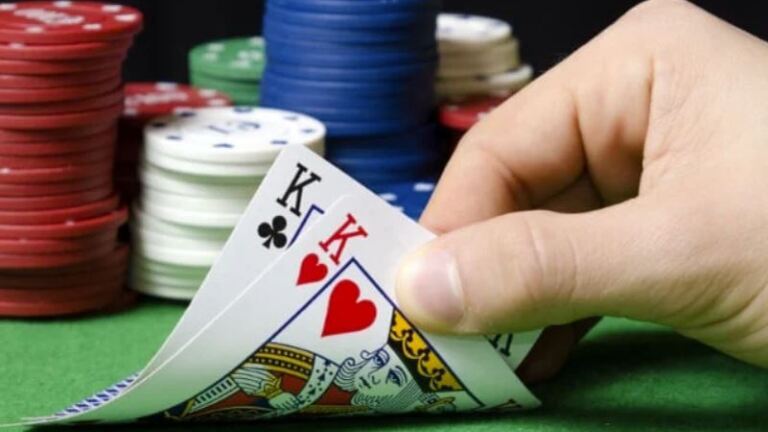What are outs, and why so important in poker?
It's crucial to recognize the cards that will help you to improve. It's not difficult to calculate, but knowing the math behind it is essential to make educated decisions at the table.

What are "outs" in poker?
In poker, "outs" refers to cards that improve your hands to beat your opponent's holdings. So, for example, when you have KK and Villain has AA, you have two outs - the two kings - to beat him (we are not calculating runouts where you make a straight, flush, etc.).
Of course, that was a very basic example. This number becomes handier once you face multiple street bets, and you are more likely to need to improve your hand. Imagine such a situation when you have a flush or a straight draw, and it's unlikely to scoop the pot without hitting your draw.
How to count your outs correctly?
First, you need to recognize the cards that would help you improve your hand, then consider all the cards left in the deck.
A common situation is having a flush draw on the flop. We have a lot of information that we can take into account already. We have two cards from the same suit, and there are two more from the same suit on the flop. Since there are 52 cards in the deck, divided by the four colours, each suit contains 13 cards (from 2 to ace). Now, we hold two as a hole card, and the flop contains another two, which leaves us with nine outs to make our flush by the river.
So why the title of this section says correctly? Well, we counted our outs to make a flush. However, we didn't consider that other cards could improve us as well, nor calculated with runouts that, even though we make our flush, will leave us still losing the pot to stronger holdings.
Let's say you have an ace-high flush draw on a flop 37sT, with A5s. If your opponent has a hand such as KT, you also have an extra three outs with all the aces. However, if your opponent has T7 on the same flop, an ace won't help. Moreover, one of the flush outs, the Ts will give your opponent a full house. So even though you complete your draw, you still lose, so you cannot count that card as a clean out.
The most common situations for counting outs;
Flush draw – 9 outs
i.e. you hold  T
T  9 on a
9 on a  J
J  6
6  4 flop
4 flop
Straight draw – 8 outs
you hold  9
9  8 on a
8 on a  J
J  T
T  2 flop
2 flop
Gutshot straight draw – 4 outs
you hold  8
8  T on a
T on a  A
A  7
7  6 flop
6 flop
A combined straight and flush draw – 15 outs (9 flush and 8 straight outs, however we’ve already counted 2 of our straight outs under flush outs, which gives us 9+6=15 outs)
you hold  T
T  9 on a
9 on a  Q
Q  J
J 2 flop
2 flop
How to use this information?
Okay, we know how to count our outs, but how will this help us decide? With this information, we can calculate our equity and the percentage of how often a certain runout will occur.
Let's continue the example with our flush draw and overcard. So the flop again; 37sT, and we are holding A5s, and Villain has KT. So we already know 5 of the 52 cards of the deck (our hole cards and the three cards on the flop), which leaves us to calculate with the 47 cards left.
We have nine flush outs and three overcard outs to hit a stronger top pair. A straightforward way to see this is; 12 of 47, or 47:12. If we simplify further, this gives us 3,92 to 1 or roughly 25,5%.
However, this number shows how often we hit one of our outs on the turn. There is still a river to come, in which we have a 46:12 (roughly 26%) chance to hit our hand. So, when you decide on the flop, you can calculate the combined number of hitting your card on the turn or the river, which gives us ~51,5%. This calculation doesn't consider occasions when we hit our hand, and we still lose to a better hand (i.e. we hit our flush, but Villain makes a full house by the river, or we hit an ace on the turn but Villain makes two pairs on the river, etc.).
During a hand, this seems like a very complicated and little practical calculation. But luckily for you, there is a simplified version of calculating your odds.

Simplified odds calculation
Poker players have a shortcut for calculating odds. Instead of going through the whole process discussed above, they just multiply the number of outs by four on the flop and by two on the turn.
If we mathematically calculate a 9-outted flush draw, we have 9/47 (19,15%) on the flop and 9/46 (19,57%) on the turn, all together 38,72%. If we multiply our nine outs by four on the flop, we get 36. Repeating the same on the turn, 2x9 outs give us 18.
This technique is a bit inaccurate and has limitations above a certain number of outs. Still, it gives a rough and relatively close idea about our odds. You'll get an unrealistically high number if you use the multiplication technique with more than nine outs on the flop. The higher number you multiply, the further it gets from reality. So we suggest adding an extra step to the equation. After multiplication by 4, deduct the number of outs minus 8, like this:
EQ = (number of outs x 4) – (number of outs – 8)
i.e. straight+flush draw hand (15 outs)
EQ = (15 x 4) – (15 - 8) = 53%
which is still closer to the actual number (54%) than just leaving the multiplied outs and getting an unrealistic 60% of odds.
Summary
Now that you have familiarised yourself with the notion of outs in poker, you can start calculating your odds and make educated guesses about whether you should call or fold. We highly recommend using a simplified multiplication strategy to get a rough number of your odds by multiplying your outs by four on the flop and by two on the turn. However, this calculation has limits since it doesn't consider unfavourable spots. For example, besides the fact we make our hand, we still lose to a better hand. Therefore, you need to be careful to only calculate with your clean outs, cards that won't give your opponent a better hand.
That's it for today guys!
Good luck calculating your odds!
Previous article: Beginner guide to online poker!















0 comments